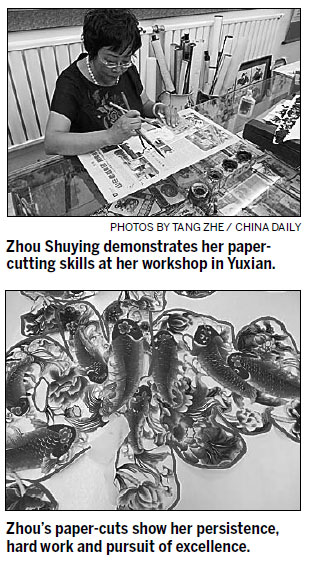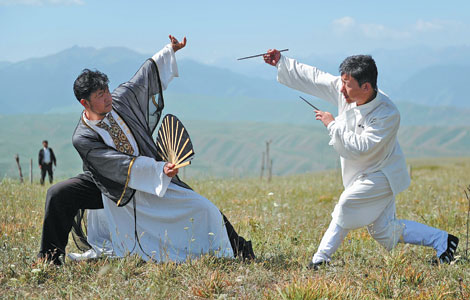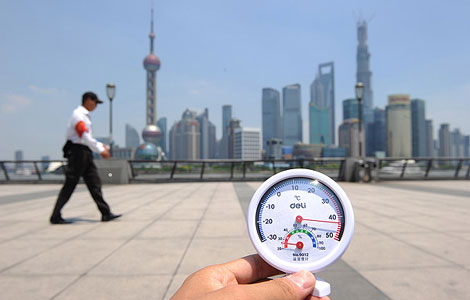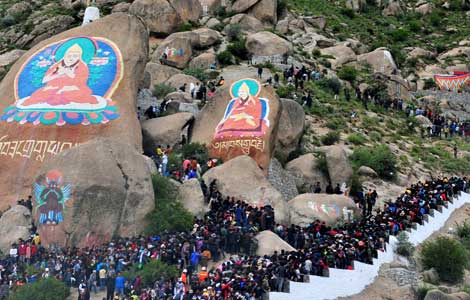Paper-cut artists strive to rise above technology
Updated: 2013-08-07 07:17
By Tang Zhe in Yuxian, Hebei (China Daily)
|
||||||||

Distinguished by their delicate composition, vivid shapes and flamboyant colors, Yuxian paper-cuts challenge people's normal understanding of these Chinese artworks as red flowers for windows. They are considered a rich and honored part of Chinese traditional folk heritage.
Yuxian County, situated in the northwest of Hebei province, is famous for its multi-colored paper-cuts, which are produced through processions of handmade patterns, blotting the paper, knife cutting and coloring.
Rather than using scissors to create detailed images and patterns, Yuxian craftsmen carve into the paper with a thin, sharp knife, which can finely slice the paper and allow the artist to focus on small details. This gives the image an essence of realism.
With a history of more than 200 years, Yuxian paper-cutting, with its unique skills and rich cultural connotations, was named a national intangible cultural heritage in 2006.
However, with computer design and mechanized production providing a faster and easier way to generate more profits, some traditional artists worry that the increasing use of modern technologies will strip the essence of the manual art.
Zhou Shuying, a renowned paper-cut artist from Yuxian, has devoted herself to preserving and developing the art.
Influenced by her father Zhou Yongming, who was the first person to produce the paper-cuts of opera masks, the 49-year-old is also a pursuer of excellence. She spends a whole day coloring a fist-sized flower, and a work of four meters long has taken her eight months to finish.
Despite her persistence in doing work by hand, Zhou sees computer-generated designs in almost every gallery of Yuxian, and says the traditional manual artists are struggling.
"The impact is huge, especially to those working in small mills. They used to be well-paid, but recently there have been many artists worrying about how to make a living faced with the technology trend," says Zhou, whose six brothers and sisters also work to pass on the art.
Zhou says the technology could contribute to the economy, but cannot deliver the inspiration to the artist. She also urged traditional artists to stay close to what their ancestors have left for them in face of technology.
Zhou also suggests the local government raise people's awareness of protecting the manual art by founding paper-cut schools, art museums and shooting paper-cut movies.
Another artist, Gao Dianliang, proposes adding painting elements would help to increase the artistic value of paper-cuts and distinguish the handmade from the mass-produced.
"Adding traditional Chinese painting will give the paper-cuts new vitality," Gao says. "Drawing could be a supplement to reflect what coloring can't achieve, and make the paper-cuts of Yuxian impossible to reproduce. It's another process of artistic creation.
"The pieces produced by machines are affordable versions for common people, while the real art must be reflected by manual work," he says.
"Paper-cuts share the same rules with calligraphy and painting, and could also match the other mediums in artistic value."
tangzhe@chinadaily.com.cn
(China Daily USA 08/07/2013 page10)
Most Viewed
Editor's Picks

|

|

|

|

|

|
Today's Top News
China vows to severely punish newborn traffickers
Sri Lanka suspends NZ milk powder imports
PV firms face risks despite EU deal
Small firms should also think global
China issues record fines for dairy firms
US, China trade deficit narrows
NBA courts Sina Corp
EC denies delay in telecoms probes
US Weekly

|

|












